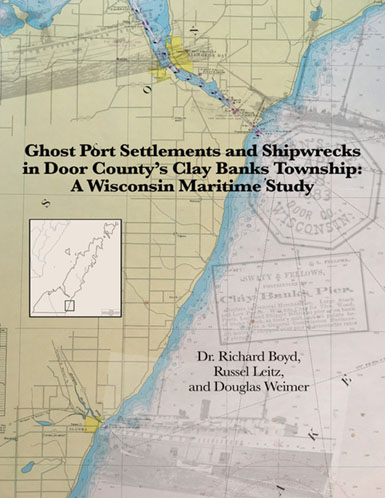Ghost Port Settlements and Shipwrecks in Door County’s Clay Banks
Township, Door County, Wisconsin: A Wisconsin Maritime Study
Wisconsin’s Door County Peninsula harbors over a dozen ghost town sites. Many of these vanished communities were actually small lake ports, associated with the logging industry and related pioneer enterprises that blossomed shortly after the Civil War. The Lake Michigan coastline of Clay Banks, the smallest township in Door County, had four such “ghost port” settlements. Maritime shipping was essential for these hamlets because roads and railways were lacking or ineffective. However, the waters off this township are fringed by numerous rocky shoals, which necessitated the construction of extensive piers to ship the products generated by logging, farming and fishing enterprises. A key interdependency evolved between these sawmill-communities and nautical commerce from their mega-piers. Despite these lengthy docks, many shipwrecks and maritime mishaps occurred on the dangerous reefs, as well as at the piers themselves. As the logging era faded, the sawmills closed, local businesses dwindled away, and the massive docks crumbled into the lake, until each settlement had virtually disappeared, leaving only underwater or underground remnants to tell their stories.
Ten years ago, the Wisconsin Underwater Archeological Association (WUAA) began this study of these extinct hamlets, both above and below water. Archival research recounts both the development and the decay of these lakeside communities, including histories of their vital sawmills and shipping docks. The hardships and complexity of the small sawmill businesses are examined, as are the lives of certain key individuals who championed civic developments and commercial enterprises in these wilderness settlements. Local shipwrecks and other maritime misfortunes are discussed, and several underwater archeological field studies are presented. In telling this story of communal rise and fall, the authors have relayed the information in a manner that hopefully captures the “flavor of those long-gone, pioneer times.”

